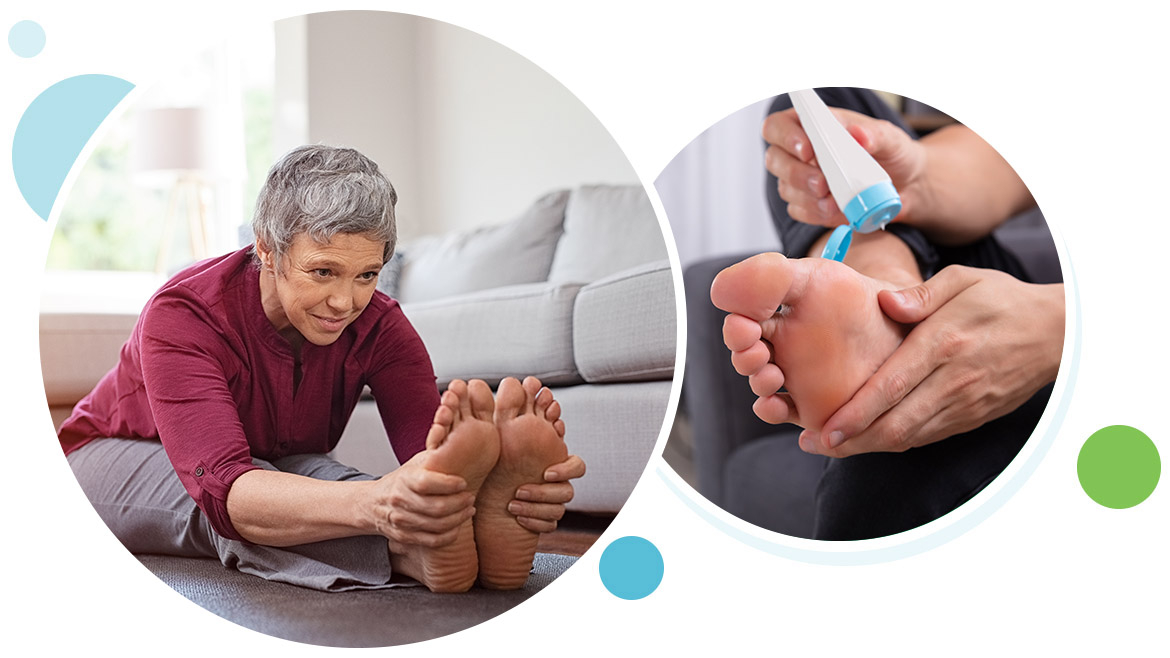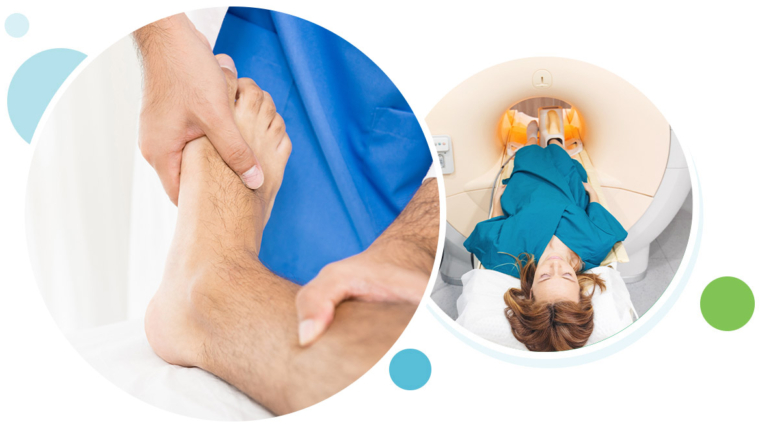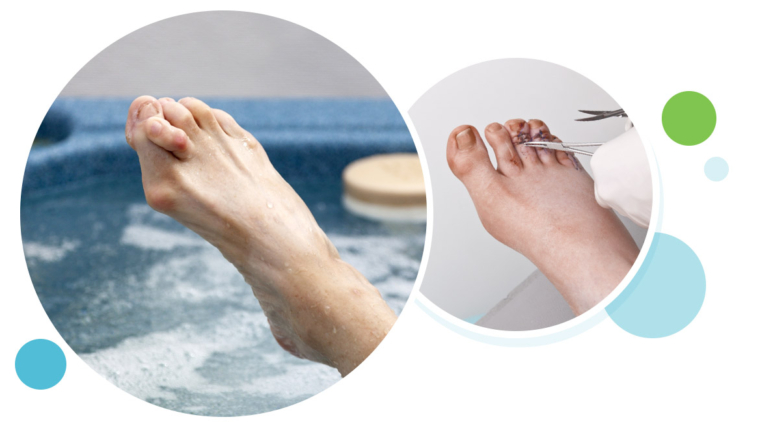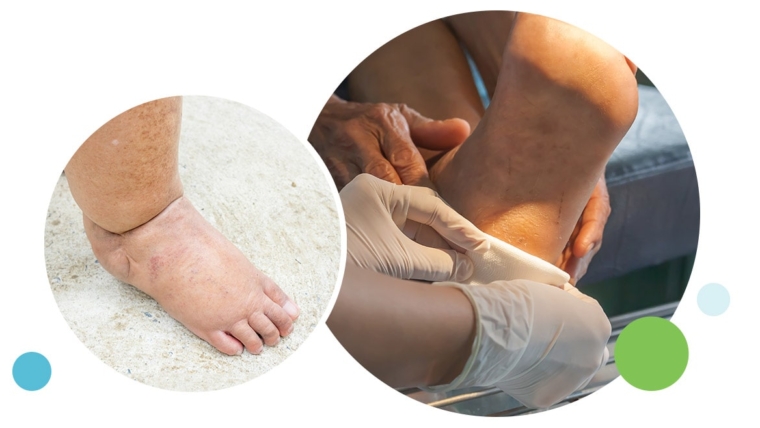Here at Northstate Foot and Ankle Specialists, we have a team of expert physicians and full-time physical therapists on-site to provide you with complete foot and ankle care. This allows you to receive comprehensive care from the Northstate family all the way through to your full recovery.
While our team of podiatric professionals can provide you with the ultimate in targeted care and treatments for your foot ailments, maintaining your foot and ankle health and preventing future injury is an on-going process that doesn’t end when you walk out the door of our office. Turning proactive self-maintenance practices into regular habits is the best way to keep your feet happy for the long run so we wanted to “walk through” some easy ways to give your lower half a little love. In this article we’ll explore eight practical ways you can maintain your foot and ankle health from the comfort of home.
1. GET A GOOD STRETCH IN
We are constantly putting stresses and strains on our lower extremities in our normal daily lives. Our muscles, joints and tendons get tested every day, even if we’re not conscious of it. When these body parts get overused, they can begin to defend themselves by contracting, tightening and stiffening. Over time, if not stretched, these body parts can lose their range of motion and affect your mobility.
The good news is that it only takes a couple minutes a day to stretch, and you’ll feel great when you’re finished! The hardest part is not the stretches themselves, but rather building a habit of stretching every day.
A few good tips to remember.
- Take it slow to start: There are no shortcuts and overstretching can do as much damage as not stretching at all.
- Breathe: Be sure to focus on your breath (it’s easy to forget to breath) while stretching. This helps to provide your problem areas with oxygen and nutrients to help increase strength, pliability and healing.
- Consistency is key: Slowly find your personal sweetspot during a sustained hold, without bouncing around. Also, consistent stretching will have a greater impact. Set an alarm and make your routine a priority. You may eventually find yourself craving a good stretch throughout the day and reluctant to stop once you begin.
- Top of the Morning: Many foot injuries occur when you’re getting out of bed and your muscles and tendons are still tight. Starting your day with some light stretching of the plantar fascia, ankle and calves followed by a light walk can help to reduce injury.
- Ask For a Plan: Depending on the seriousness of your foot condition, you should speak with a podiatrist or physical therapist to learn what stretches are best (and worst) for you.
There are many different stretches that you can try, even while sitting in a chair or standing idle. This article from Healthline shows 9 different foot exercises you can try without ever getting onto the floor. You can also use household items to enhance your stretch and massage your feet, such as dish towels and tennis balls.
2. SOAKING THE STRESS AWAY
If your feet are sore or swollen, one easy method for alleviating foot pain at home is to soak in a warm bath with epsom salts for about 20 minutes. Simply draw a warm bath and add one cup of epsom salt into the tub. Letting your legs & feet soak in the bath will encourage your tensed muscles, tendons and nerves to relax while improving blood flow and reducing swelling. This can help with issues such as low grade ingrown toenails, bad circulation, foot cramps & helps prevent fungal infections.
3. KNOWING YOUR PHYSICAL LIMITS
Prevention is the best medicine and knowing your own physical limits is essential to avoid painful foot and leg injuries in the first place. Be aware of any past or current injuries, as well as your general fitness level before you undertake a strenuous physical task. Your body gets injured when you push beyond its healthy range of motion, strength or endurance and most often, taking just a little extra time, being better prepared or asking for some help can help you maintain your foot health at home. If you expect to physically exert yourself, even with housework, be sure to properly warm up with a little stretching and take short breaks so your muscles don’t get fatigued.
4. TAKING CARE OF YOUR TOENAILS
Properly trimming, cleaning and grooming your toenails on a regular basis is one of the best ways to maintain your foot health at home and to avoid common issues like ingrown toenails and toenail fungus. A good nail trimming and cleaning kit is inexpensive and will help you be more effective with your grooming. Always be sure to thoroughly wash your feet after you’ve been walking around in shoes or boots for extended periods. If you are in pain or have symptoms that are not going away, you should contact a podiatrist right away who can help you determine the best way to immediately address the problem. Procrastinating treatment is likely to only cause the problem and your discomfort, to worsen.
5. SPORTING THE RIGHT FOOTWEAR
Every foot is different and most shoes do not properly support the unique way each of us use our feet. In fact, a large number of all podiatric issues come from patients who wear improperly matched footwear for their body, women who wear high heels, or from shoes that are too tight. This is just as true and important whether you are at home or out on the town. Wearing shoes that are not a good fit for you can result in issues such as hammertoes, bunions, heel pain, neuromas or ingrown toenails. You can review ProLab’s Shoe Recommendations on our website and our team of experts at Northstate can help you determine what shoes are best for your feet and if you need orthopedic inserts.
6. REST, ICE, COMPRESSION & ELEVATION (R.I.C.E.)
Should you experience a foot or ankle injury at home, you can take immediate action to relieve pain and swelling and promote healing and flexibility using the easy to remember acronym “RICE”. RICE is shorthand for Rest, Ice, Compression, and Elevation.
After an injury, rest and protect the injured or sore area. Stop, change, or take a break from any activity that may be causing your pain or soreness.
Applying cold right away will then reduce pain and swelling. You can use an ice or cold pack for 10 to 20 minutes with a towel, 3 or more times a day, but do not apply the ice directly to your skin. After 48 to 72 hours, if swelling is gone, apply heat to the area that hurts. Heat is better than cold for sore, aching, or more long-term injuries that do not involve inflammation, but should be used no earlier than 3 days after an injury, and only after inflammation has resolved.
Compression, or wrapping the injured or sore area with an elastic bandage (such as an Ace wrap), will help decrease swelling. Don’t wrap it too tightly, because this can cause more swelling below the affected area. Loosen the bandage if it gets too tight. Be aware of signs that the bandage is too tight include numbness, tingling, increased pain, coolness, or swelling in the area below the bandage. Talk to your doctor if you think you need to use a wrap for longer than 48 to 72 hours as you may have a more serious problem.
Elevate the injured or sore area on pillows while applying ice and anytime you are sitting or lying down. Try to keep the affected area at or above the level of your heart to help minimize swelling.
7. TREAT YOURSELF TO A MASSAGE
Massaging your feet and lower legs at home can help you alleviate soreness, improve circulation and relax tense muscles. Even if your significant other isn’t keen on giving you a foot rub, there are many techniques you can use to massage your own feet. For example, one method is to sit in a comfortable chair and simply rub and knead the bottoms of your feet, pulling apart and bending your toes to massage them. Lacrosse balls can be used to gently roll out tension on your foot arches when there are no injuries. Also, use lotion or oil to help lubricate your skin, making it easier to massage the foot.
Products like foot rollers, or even frozen water bottles, may also help massage the foot as you roll it on the floor with your feet. There are also electric foot massagers now available that can work on your feet (without complaint) while you sit, leaving you free to focus on something else at home. Be sure to follow manufacturers specifications and don’t use mechanical massage if you have existing injuries unless under the supervision of a professional.
8. SCHEDULE A TELEMEDICINE APPOINTMENT ONLINE
Even though we would always prefer to see you face to face, we now offer an excellent way to maintain your foot and ankle health at home with our Telemedicine Appointments. You can now schedule a video call with one of our doctors whether you just have a few questions, would like a proactive consultation to learn the best ways to keep your feet happy, or need expert advice on treating a foot, ankle or lower leg issues. We’re here to help! Most insurers cover telemedicine and your video appointment with a doctor is secure.
As we have reviewed above, there are many great ways for you to maintain your foot and ankle health while staying at home. Incorporating these habits into your regular routine will yield major benefits down the road for keeping your feet, ankles and lower legs happy and for letting you live a full life. Some foot and ankle problems, however, may require more specialized treatments and guidance. If you are experiencing foot or ankle pain, contact us today for a consultation with our professional staff of foot and ankle specialists. Our expert team at North State Foot and Ankle can help you get back to your active, healthy, pain free lifestyle.




